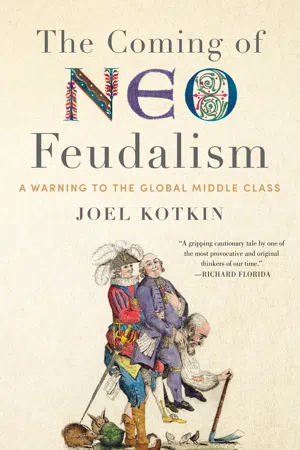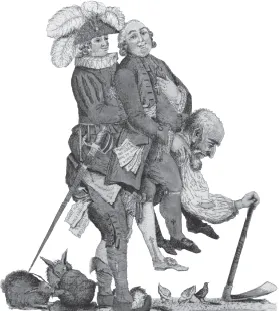![]()
PART I
How Feudalism Came Back
History never repeats itself. Man always does.
—Voltaire
![]()
CHAPTER 1
The Feudal Revival
Feudalism is making a comeback, long after it was believed to have been deposited into the historical dustbin. Of course it will look different this time around: we wont see knights in shining armor, or vassals doing homage to their lords, or a powerful Catholic Church enforcing the reigning orthodoxy. What we are seeing is a new form of aristocracy developing in the United States and beyond, as wealth in our postindustrial economy tends to be ever more concentrated in fewer hands. Societies are becoming more stratified, with decreasing chances of upward mobility for most of the population. A class of thought leaders and opinion makers, which I call the “clerisy,” provide intellectual support for the emerging hierarchy. As avenues for upward mobility are diminishing, the model of liberal capitalism is losing appeal around the globe, and new doctrines are arising in its place, including ones that lend support to a kind of neo-feudalism.
Historically, feudalism was hardly a monolithic system, and it lasted much longer in some places than others. But certain salient features can be seen in feudal structures across medieval Europe: a strongly hierarchical ordering of society, a web of personal obligations tying subordinates to superiors, the persistence of closed classes or “castes,” and a permanent serflike status for the vast majority of the population.1 The few dominated the many as by natural right. Feudal governance was far more decentralized than either the Roman Empire that preceded it or the nation-states that followed, and it depended more on personal relationships than does liberal capitalism or statist socialism. But in the feudal era a static ideal of an ordered society, supported by a mandatory orthodoxy, prevailed over dynamism and mobility, in a condition of economic and demographic stagnation.
The clearest parallel in our own time is the concentration of wealth in fewer hands, following upon an era of robust social mobility. In the second half of the twentieth century, growing prosperity was widely shared in the developed world, with an expanding middle class and an upwardly mobile working class—something seen in many developing countries as well. Today, the benefits of economic growth in most countries are going mainly to the wealthiest segment of the population. One widely cited estimate suggests that the share of global wealth held by the top 0.1 percent of the global population increased from 7 percent in 1978 to 22 percent in 2012.2 A recent British parliamentary study indicates that this global trend will continue: by 2030, the top 1 percent is expected to control two-thirds of the world’s wealth.3
This wealth tends to be handed down from one generation to the next, creating something akin to a closed aristocracy. It may not have a legally privileged status or political power by right of inheritance, but its wealth can buy influence with government and over the culture. Thus we see an oligarchy emerging in supposedly democratic countries, with a neo-feudal aristocracy grafted onto a powerful central state.
As in the Middle Ages, the power and privilege of this oligarchy are supported by an influential cognitive elite, or what I call the clerisy. The term was coined by Samuel Taylor Coleridge, who envisioned a group of secular intellectuals guiding society with their knowledge, as the cultural role of the church waned. Today’s clerisy are the people who dominate the global web of cultural creators, academia, the media, and even much of what remains of traditional religious institutions. They share many beliefs with the oligarchs—on globalism and the environment, for example—and spread them around to the wider population as a secular orthodoxy. But like the medieval clergy, they sometimes act as a check on the power of economic elites.
The clerisy and the oligarchy correspond to the medieval clergy and nobility—or the First Estate and Second Estate, as they came to be known in France. Beneath them are the vastly larger group corresponding to the “commoners” in the feudal era, or the Third Estate: those who were neither anointed nor ennobled. Today’s Third Estate, which I call the “yeomanry,” has two distinct parts. There is a property-owning middle class, analogous to the old English yeomanry but with the same spirit of independence transported into an urban or suburban context. Historically the yeomanry played a critical part in overturning the feudal order—but today their counterparts are being squeezed beneath the oligarchy. Second, there is a working class who are becoming more like medieval serfs, with diminishing chances of owning significant assets or improving their lot except with government transfers.
Although the two groups that constitute the Third Estate are falling behind, they can still pose a challenge to the oligarchs and the clerisy, as they are no longer quiescent in the face of globalism and technological obsolescence. We are seeing what one sociologist describes as “the defection of the working class” from a traditional allegiance to the political left, along with a simultaneous rejection of global capitalism and its cosmopolitan value structure.4 Though the challenge to the oligarchy tends to come from the populist right, there are other forces that could attack from another direction, particularly younger workers and the less affluent portions of the clerisy, who together might form what one conservative writer has described as “a zombie army of anti-capitalists.”5 Even as a new feudalism appears to be setting in, it is stirring up counterforces that promise turbulent times.
History Also Regresses
History does not always move forward, to a more advanced or enlightened condition. The collapse of classical civilization is a case in point. That civilization had its cruel and unjust aspects, including the extensive use of slaves, but it also engendered cultural, civic, and economic dynamism that spread from the Near East to Spain, North Africa, and Britain. It developed a body of philosophy, law, and institutional forms that laid the basis of modern liberalism. But as classical civilization unraveled—from a combination of internal dysfunction and external pressure—its territories devolved into political disorder, cultural decline, and economic and demographic stagnation.
While we can put a date to the end of the Roman Empire in the West, the process of cultural decline extended over centuries. The backward trajectory is clear by the sixth or seventh century, in the demise of learning, the rise of religious fanaticism, the decline of cities and the collapse of trade, and Malthusian stagnation: Europe’s population in the year 1000 was about the same as it had been a millennium earlier.6 The formerly vibrant urban middle orders had faded away, and the class of landowning peasants shrank as agricultural land was consolidated into huge estates. Class relations became more rigidly hierarchical, with a hereditary nobility and powerful clerics at the top. These ruling classes often competed and fought among themselves, but they were distinctly privileged in comparison with most of the population, who would endure life as landless serfs. The ideal vision of society was static, and the aim was not to find new fields to plow, not to innovate or grow, but instead to maintain an equilibrium within a largely fixed system.7
In the second millennium, markets and towns began to grow again, craft guilds formed, philosophy and learning quickened. The Third Estate was rising: both rural smallholders and a prospering, literate bourgeoisie in the growing cities. With prosperity came a bigger public voice, and the Catholic Church and the nobility gradually lost power as a consequence. A system based on free markets, liberal values, and a belief in progress evolved in Europe and spread to North America and Oceania.
Like all social structures, the liberal order brought its own injustices. Most shamefully, slavery was revived and extended to newly colonized territories. In addition, the industrial revolution replaced cottage industries with factories and created an impoverished urban proletariat living at the very edge of subsistence. But during the twentieth century, especially after the Second World War, life became measurably better even for most of the working class, and the middle orders continued to grow in prosperity and numbers. Some government action came into play—for example, subsidizing homeownership, building new infrastructure, and permitting labor unions. Linking such policies to the engines of economic growth promoted a mass movement to affluence, the premier achievement of liberal capitalism.
Although liberal capitalism has generated many social, political, and environmental challenges, it has freed hundreds of millions from the widespread servility, entrenched cruelty, and capricious regimes that have dominated most of history. The material conditions of life have improved dramatically, not only in Europe and America but throughout much of the world. In the five hundred years up to around 1700, economic output per capita was flat, which means that a person of median income in 1700 was no better off, economically speaking, than the average person in 1200. By the mid-1800s, particularly in the West, economic output had increased markedly; the growth accelerated after 1940 and spread to the rest of the world.8
Bending the “Arc of History”
Liberal capitalism first fueled Western dominance, and then the economic rise of other countries as well. The economic boom that followed the end of the Second World War and extended to large parts of the world with the collapse of Communism nurtured confidence about the global future. The key to increasing prosperity appeared to be in our hands. Optimistic notions about an “arc of history” bending inexorably to greater prosperity and social justice were embraced on both right and left—for example, by President George W. Bush and by President Barack Obama.9
Beginning in the 1970s, the arc started bending backward in the regions that gave birth to capitalism and modern democracy—Europe, Australia, and North America. Upward mobility for the middle and working classes began to stall, while the fortunes of the upper classes rose dramatically. Economies kept growing, but most of the benefits were harvested by the very rich—the top 1 percent and especially the top 0.1 percent—while the middle classes lost ground.10
In 1945–1973, the top 1 percent in America captured just 4.9 percent of total U.S. income growth, but in the following two decades the richest 1 percent gobbled up the majority of U.S. growth.11 The combined wealth of the richest four hundred Americans now exceeds the total wealth of 185 million of their fellow citizens.12 In European countries, with their socialistic welfare policies, the upper middle class pays very high taxes while the wealthiest find ways to hide their income sufficiently to maintain and even increase their dominance. Surprisingly, in progressiveoriented countries such as Finland, stock ownership is considerably more concentrated among the very richest people than in the United States.
The trend is not only a Western one. In avowedly socialist China, for example, the top 1 percent of the population hold about one-third of the country’s wealth, and roughly 1,300 individuals hold about 20 percent. Since 1978, China’s Gini coefficient, which measures inequality of wealth distribution, has tripled.13 Globally, the ultra-rich are an emergent aristocracy. Fewer than one hundred billionaires together now own as much as half of the world’s assets, the same proportion owned by around four hundred people a little more than five years ago.14
The concentration of wealth is also clear in property ownership. In the United States, the proportion of land owned by the one hundred largest private landowners grew by nearly 50 percent between 2007 and 20...



